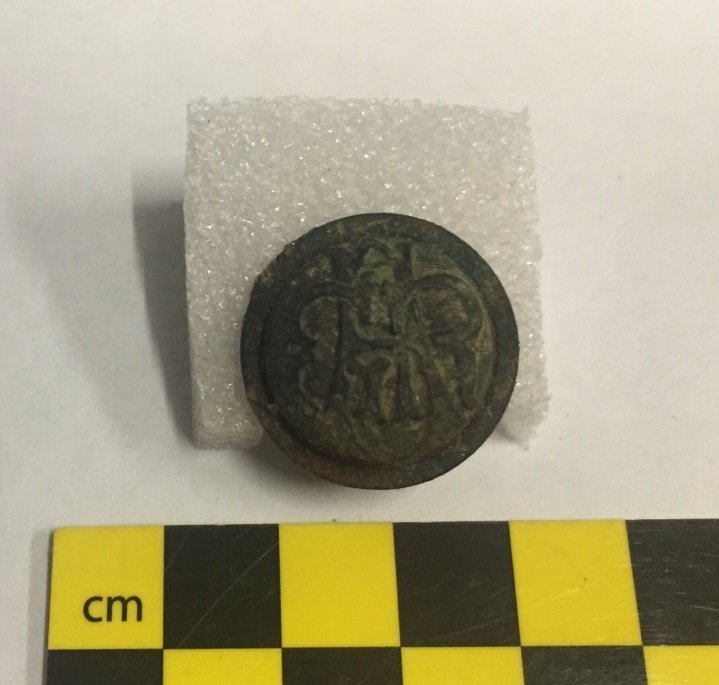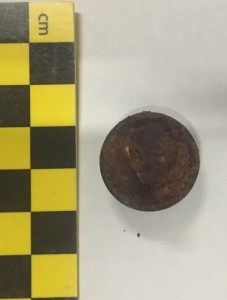In this blog post we are taking a closer look at an artifact recovered from archaeological investigations at the Lighthouse in 1996. The small object pictured is a domed brass button with the letter G, A and R artistically embossed on the surface. The letter GAR refers to the Grand Army of the Republic.
For those unfamiliar with this organization GAR was founded in Illinois, 1866 by Benjamin F. Stephenson. The membership to this organization was limited to honorably discharged veterans of the Union Army, Navy, Marine Corps or the Revenue Cutter Service that served during the Civil War. While this was a national organization within it there was a hierarchy with “Departments” designated at the state level that were comprised of local community groups called “Posts”. Each post had its own number and often a name as well. Confederate veterans also formed a similar organization referred to as the United Confederate Veterans.
These organizations served to help Civil War veterans. They lobbied for pension plans, developed medical facilities and soldier’s homes for vets and preserved memories. In St. Augustine, there were two GAR posts, H.W. Chatfield Post and John A. Logan Post. The Logan Post was established by African-American Civil War veterans that served in the Union military. GAR at its height around 1890 had over 400,000 members nationally. Over time the organization declined and dissolved in the 1950s with the passing of the last members. Records for these posts in St. Augustine are rather limited, but we do know they were active in the late 1800s into the early 20th century.
The GAR button was recovered from a test excavation unit, and more specifically known as “Feature 1.” Features, archaeologically speaking, are physical elements created or modified by humans that are non-portable or stationary. Common features include remnants of structure, drains, cisterns, fire pits, and trash pits. In the case of Feature 1, the function was a trash pit.
Archaeologists love finding features such as this as they usually are full of material culture or artifacts that can provide significant information about the time period, the people that left the objects behind or perhaps function of a particular archaeological site. In our case, being a Lighthouse, we have some idea already as to who left the objects and the function of the site. Since this lighthouse is a relatively recent historical site we also have the advantage of using historical records.
Feature 1 was discovered in a test excavation unit located east of the U.S. Coast Guard Barracks on site. This feature was large and rectangular in shape. The excavation of the trash pit produced hundreds of bottles and bottle fragments, ceramics, metal objects (like cans) and personal items including the GAR button. We know the keepers buried their trash at the Lighthouse in several areas based on records and oral histories. This was not an uncommon practice, historically, and even more frequent since they were isolated on Anastasia Island.
So how did this button turn up at the Lighthouse?
One possible answer to this question was the button belonged to one of the Keepers’ families and was thrown away with the other objects in the trash pit. As we look at the history of our keepers at the Lighthouse, the first name that is on top of the list is Keeper Harn. Keeper Harn has a very interesting Civil War background ending the war with the rank of Brevet Major. He was present at the start of the war at Fort Sumter and was at some of the most important battles of the war including Gettysburg.
After the war, Harn eventually began to work for the U.S. Lighthouse Establishment and transferred to St. Augustine Lighthouse in 1875 and served as head keeper until his death in 1889. As we examine some of the historical records about GAR in St. Augustine, Harn is listed on the GAR Chatfield Post membership roster, and Harn’s obituary also mentions being a member of GAR. So the “dots” seem to be lining up that the GAR button is possibly an artifact belonging to Harn. This would be rather exciting for us.
However, if this is the case then the archaeology needs to support it as well. To make this case, one needs to look at the context of the button in relation to other artifacts recovered. The archaeologists who conducted the excavation and analysis state based on the artifacts recovered from Feature 1 that the pit was created in filled in the 1920s or early 1930s. This is based on an overall age range of the artifacts recovered, and the soil deposit properties, which reflect that the pit was a one-time event or short-term disposal. Since Harn passed away 1889 and his family left the end of that year, this would suggest that button does not belong to Harn due to the age of the trash pit. While disappointing we can examine the artifact assemblage a bit further.
Though early 20th century artifacts dominate the artifact assemblage, there are a few artifacts recovered that date earlier. For instance, a bone toothbrush with extra fine holes was dated to 1890-1890. Additionally, some of the pottery dates to the early 1890s as well. It’s hard to imagine a toothbrush from the 1890s being used for over 20 years then thrown away. The other issue at hand is that while there are artifacts that date close to Harn’s time at the Lighthouse, the GAR button certainly could have been something that was curated by people as an heirloom. So, the button certainly could be from the late 1800s, but perhaps belonged to another keeper’s family at the Lighthouse closer to the time period of the trash pit. Currently, we have not found a connection with another keeper family and GAR; however, this is certainly possible.
Archaeologists can make some great discoveries, but sometimes the work creates a larger puzzle to solve. At this point we cannot say definitely that the GAR button belonged to Harn, but it’s certainly possible. Currently, we sent the button to our conservation staff to help preserve and clean up the button. It is hoped that we may find a manufacture name on the back of the button, which might provide additional clues. The research will continue, so stay tuned for additional updates!
Jason Titcomb is the Chief Curator for the St Augustine Lighthouse & Maritime Museum. He holds a graduate degree in anthropology from Iowa State University.



